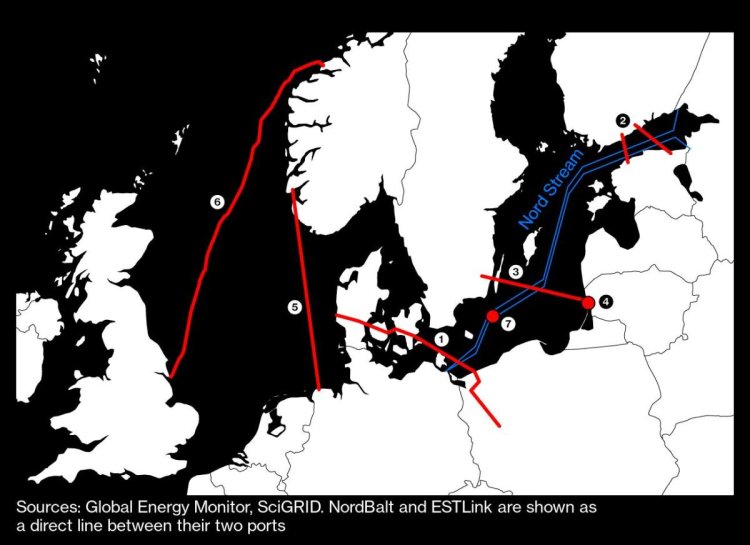Finland Pipeline Sabotage Proof Would Draw NATO Response
(Bloomberg) -- NATO Secretary General Jens Stoltenberg cautioned that any deliberate damage to the alliance’s critical infrastructure would warrant a response after an undersea gas pipeline was ruptured in a suspected act of sabotage in Finland.Most Read from BloombergIsrael Latest: Israeli Death Toll in Hamas Attack Reaches 1,200Hamas Got Around Israel’s Surveillance Prowess by Going DarkIsrael Latest: Top US General Warns Iran to Stay Out of ConflictAfghanistan’s Viral Supercar Makes Global Debut at Doha ShowChina Mulls New Stimulus, Higher Deficit to Meet Growth GoalAs Finland investigates what caused the damage, Stoltenberg said that defense ministers from the North Atlantic Treaty Organization will discuss the topic during a meeting in Brussels.ADVERTISEMENTAdvertisement“The important thing now is to establish what happened and how this could happen,” Stoltenberg told reporters Wednesday. “If it is proven to be a deliberate attack on NATO critical infrastructure, then this will be


(Bloomberg) -- NATO Secretary General Jens Stoltenberg cautioned that any deliberate damage to the alliance’s critical infrastructure would warrant a response after an undersea gas pipeline was ruptured in a suspected act of sabotage in Finland.
Most Read from Bloomberg
Israel Latest: Israeli Death Toll in Hamas Attack Reaches 1,200
Hamas Got Around Israel’s Surveillance Prowess by Going Dark
Israel Latest: Top US General Warns Iran to Stay Out of Conflict
Afghanistan’s Viral Supercar Makes Global Debut at Doha Show
China Mulls New Stimulus, Higher Deficit to Meet Growth Goal
As Finland investigates what caused the damage, Stoltenberg said that defense ministers from the North Atlantic Treaty Organization will discuss the topic during a meeting in Brussels.
“The important thing now is to establish what happened and how this could happen,” Stoltenberg told reporters Wednesday. “If it is proven to be a deliberate attack on NATO critical infrastructure, then this will be serious but will also be met by a united and determined response from NATO.”
The gas pipeline connecting NATO members Finland and Estonia started leaking at the weekend, and people familiar with the matter said on Tuesday the investigation is proceeding on the basis that it was sabotage. Finnish Prime Minister Petteri Orpo told reporters that it was caused by an “external source” as he declined to speculate who may be responsible.
The pipeline that was damaged in the early hours of Sunday is ruptured on one side and dragged out of place, according to Estonian military officials.
“Something has dragged this pipe from one side to the other,” Estonian Navy Commander Juri Saska told Estonian public broadcaster ERR Tuesday night.
The Most Vulnerable Sites
“If I try to paint a picture of what I’ve seen without showing it to you, then the pipe itself is covered with a concrete shell,” Saska said. “And it looks just as if someone has torn it from the side and the concrete has broken off or peeled off from the damaged area.”
Finland identified a small seismic event at the time when the pipeline was damaged, seismologist Jari Kortstrom at the University of Helsinki said by phone. The magnitude is so small that a couple of kilograms of TNT could be enough to cause such a blast, but it’s not certain the event was caused by an explosion, he said.
Finland had initially said nothing indicated a blast on the Gulf of Finland that night.
Finland is securing critical infrastructure and increasing vigilance, Orpo said. The National Bureau of Investigation has opened a criminal investigation.
The Finnish Border Guard’s patrol ship Turva identified the leak’s location on Tuesday. It’s in Finland’s so-called exclusive economic zone that spans 200 nautical miles from the coast but outside its territorial waters — a distinction that may prove important as countries weigh their response.
Data compiled by Bloomberg shows the patrol vessel at the site during the day. An undersea communications cable between the two countries has also been damaged.
While the rupture of the pipeline is not significant for the wider European gas market, it raises questions about security of supply just as Europe goes into winter. Russia halted gas flows to Finland in May 2022, about a week after the Nordic country said it would apply for NATO membership in response to Moscow’s invasion of Ukraine.
Norway, a key supplier of gas to continental Europe, on Tuesday said it’s maintaining an increased security level on gas infrastructure, put in place in the spring of 2022.
Since the Nord Stream explosions almost one year ago, NATO has increased its naval patrols in the North Sea and is racing to develop new technologies, including undersea drones, that could help detect suspicious activity on undersea systems in real-time. Attributing attacks is a particular challenge in light of the scale and depth underwater of the infrastructure.
While NATO has not laid on blame on particular actor for the latest incident, it has repeatedly warned that Russia is mapping critical undersea systems, saying there was significant risk that Moscow could target infrastructure in Europe and North America.
Highlighting the increasing importance of subsea security, NATO allies agreed in July to establish a new maritime center for undersea critical infrastructure at its maritime command in Northwood, UK. They also agreed to set up a network to improve information sharing between NATO, its allies and the private sector, to act fast on any intelligence.
--With assistance from Leo Laikola.
(Updates with NATO activity in final three paragraphs)
Most Read from Bloomberg Businessweek
The War in Israel Shows How Social Media’s Idealistic Era Has Ended
Worst US Bond Selloff Since 1787 Marks End of Free-Money Era
©2023 Bloomberg L.P.
What's Your Reaction?

















